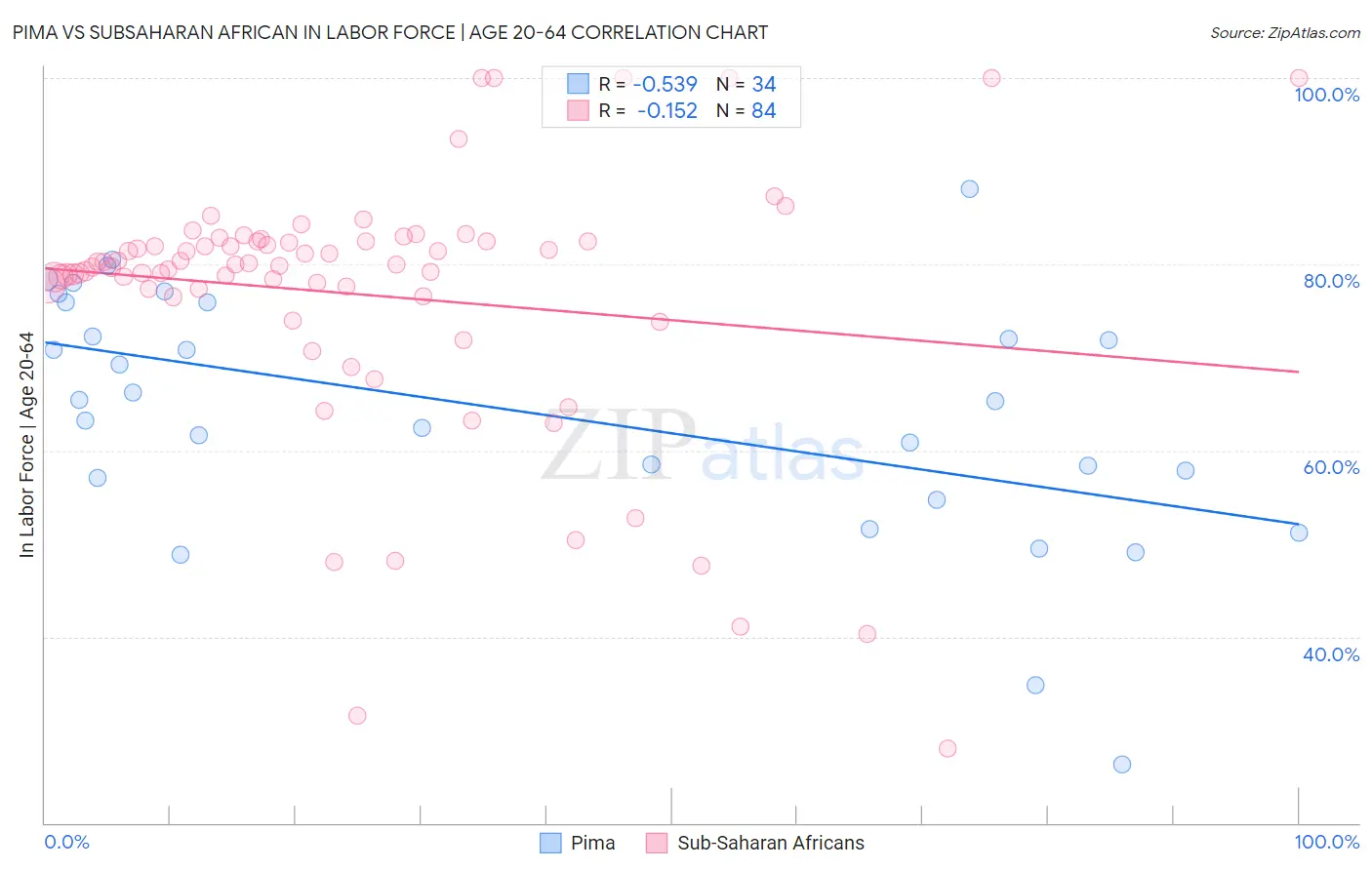Pima vs Subsaharan African In Labor Force | Age 20-64
COMPARE
Pima
Subsaharan African
In Labor Force | Age 20-64
In Labor Force | Age 20-64 Comparison
Pima
Sub-Saharan Africans
69.0%
IN LABOR FORCE | AGE 20-64
0.0/ 100
METRIC RATING
347th/ 347
METRIC RANK
79.3%
IN LABOR FORCE | AGE 20-64
16.5/ 100
METRIC RATING
207th/ 347
METRIC RANK
Pima vs Subsaharan African In Labor Force | Age 20-64 Correlation Chart
The statistical analysis conducted on geographies consisting of 61,542,645 people shows a substantial negative correlation between the proportion of Pima and labor force participation rate among population between the ages 20 and 64 in the United States with a correlation coefficient (R) of -0.539 and weighted average of 69.0%. Similarly, the statistical analysis conducted on geographies consisting of 508,214,939 people shows a poor negative correlation between the proportion of Sub-Saharan Africans and labor force participation rate among population between the ages 20 and 64 in the United States with a correlation coefficient (R) of -0.152 and weighted average of 79.3%, a difference of 14.8%.

In Labor Force | Age 20-64 Correlation Summary
| Measurement | Pima | Subsaharan African |
| Minimum | 26.3% | 28.0% |
| Maximum | 88.1% | 100.0% |
| Range | 61.8% | 72.0% |
| Mean | 64.1% | 76.8% |
| Median | 65.3% | 79.9% |
| Interquartile 25% (IQ1) | 57.1% | 76.9% |
| Interquartile 75% (IQ3) | 75.9% | 82.4% |
| Interquartile Range (IQR) | 18.8% | 5.5% |
| Standard Deviation (Sample) | 13.4% | 14.1% |
| Standard Deviation (Population) | 13.2% | 14.0% |
Similar Demographics by In Labor Force | Age 20-64
Demographics Similar to Pima by In Labor Force | Age 20-64
In terms of in labor force | age 20-64, the demographic groups most similar to Pima are Navajo (69.2%, a difference of 0.16%), Tohono O'odham (70.4%, a difference of 2.0%), Lumbee (70.6%, a difference of 2.3%), Hopi (71.7%, a difference of 3.9%), and Yuman (71.7%, a difference of 3.9%).
| Demographics | Rating | Rank | In Labor Force | Age 20-64 |
| Natives/Alaskans | 0.0 /100 | #333 | Tragic 73.9% |
| Apache | 0.0 /100 | #334 | Tragic 73.7% |
| Ute | 0.0 /100 | #335 | Tragic 73.7% |
| Crow | 0.0 /100 | #336 | Tragic 73.3% |
| Yup'ik | 0.0 /100 | #337 | Tragic 73.2% |
| Puerto Ricans | 0.0 /100 | #338 | Tragic 73.1% |
| Houma | 0.0 /100 | #339 | Tragic 72.7% |
| Pueblo | 0.0 /100 | #340 | Tragic 72.6% |
| Immigrants | Yemen | 0.0 /100 | #341 | Tragic 72.3% |
| Yuman | 0.0 /100 | #342 | Tragic 71.7% |
| Hopi | 0.0 /100 | #343 | Tragic 71.7% |
| Lumbee | 0.0 /100 | #344 | Tragic 70.6% |
| Tohono O'odham | 0.0 /100 | #345 | Tragic 70.4% |
| Navajo | 0.0 /100 | #346 | Tragic 69.2% |
| Pima | 0.0 /100 | #347 | Tragic 69.0% |
Demographics Similar to Sub-Saharan Africans by In Labor Force | Age 20-64
In terms of in labor force | age 20-64, the demographic groups most similar to Sub-Saharan Africans are Immigrants from Ecuador (79.3%, a difference of 0.0%), British (79.3%, a difference of 0.0%), Bangladeshi (79.3%, a difference of 0.0%), Immigrants from Congo (79.3%, a difference of 0.010%), and Haitian (79.3%, a difference of 0.010%).
| Demographics | Rating | Rank | In Labor Force | Age 20-64 |
| Immigrants | Oceania | 19.1 /100 | #200 | Poor 79.3% |
| Immigrants | Nicaragua | 19.0 /100 | #201 | Poor 79.3% |
| Nicaraguans | 18.3 /100 | #202 | Poor 79.3% |
| Iraqis | 17.7 /100 | #203 | Poor 79.3% |
| Immigrants | Cambodia | 17.6 /100 | #204 | Poor 79.3% |
| Immigrants | Congo | 17.5 /100 | #205 | Poor 79.3% |
| Immigrants | Ecuador | 16.9 /100 | #206 | Poor 79.3% |
| Sub-Saharan Africans | 16.5 /100 | #207 | Poor 79.3% |
| British | 16.5 /100 | #208 | Poor 79.3% |
| Bangladeshis | 16.4 /100 | #209 | Poor 79.3% |
| Haitians | 16.1 /100 | #210 | Poor 79.3% |
| Europeans | 15.3 /100 | #211 | Poor 79.3% |
| Irish | 13.2 /100 | #212 | Poor 79.3% |
| Immigrants | Portugal | 12.8 /100 | #213 | Poor 79.3% |
| Immigrants | Armenia | 12.2 /100 | #214 | Poor 79.2% |